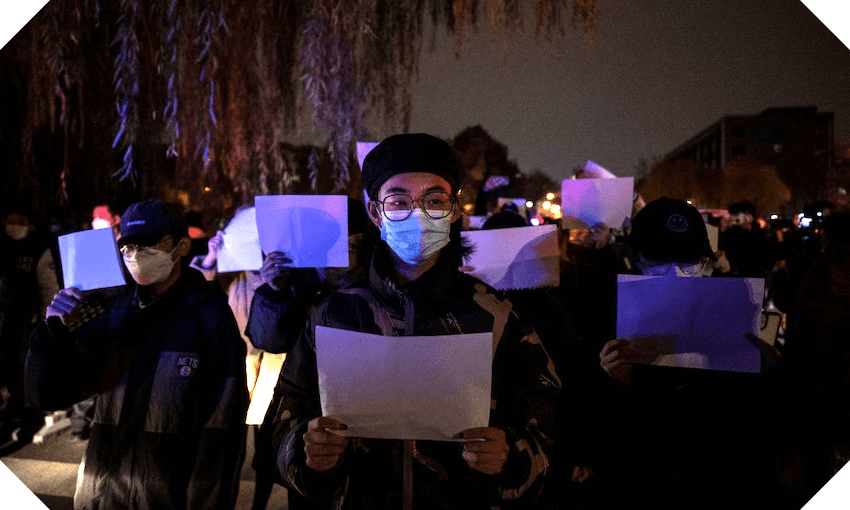‘White paper’ protests have sprung up across China after at least 10 Uyghurs died while locked in an apartment fire in Urumqi, Xinjiang. Tze Ming Mok explains.
Wtf, did these protests come out of nowhere?
Nope. After China’s government successfully eliminated Covid via mass lockdowns in the first 2020 wave, President-for-life Xi Jinping doubled down on Covid Zero for subsequent waves and has used it as a cover for expanding the oppressive power of the state to cement his own personal authority. This has meant two years of incredibly draconian population controls, particularly in Xinjiang, and constant mass PCR testing (not even RATs!), at the expense of investing in a decent vaccination and hospital capacity strategy.
The Chinese government right now is kind of where New Zealand was during our 2021 delta lockdown – struggling with a pivotal choice, with a restive population and more infectious variants scaling its defences. But China has no exit plan via effective mass vaccination (not that New Zealand has very effective mass vaccination, but that’s another story). China still has failed to develop an MRNA vaccine of its own, and has approved none for domestic use – which is, as this domestic pharma-guy says, mind-boggling. Its Sinovac and Sinopharm vaccines are simply not that good, even though propaganda encouraged Chinese citizens and the diaspora to believe they were the most racially effective for Chinese people, as if that’s a thing. Xi Jinping’s bet did not pan out. Nationalism is a helluva drug, but along with PRC vaccines, it only seems about 60% effective right now.
Didn’t China just relax its Covid controls though?
The recent post-Party Conference shift to “dynamic” Covid Zero is meant to have been a relaxing of the grip, but as more infectious variants take hold, the “dynamic” pockets of control are actually now covering more of the population than ever before. On the first day of dynamic Covid Zero, Chongqing (pop. 20 million), went into lockdown. And it’s not that dynamic to be locked into a burning building.
What happened with the burning building?
Urumqi, the capital of Xinjiang, had been in lockdown for months, with Uyghur neighbourhoods particularly targeted for heavy-handed restrictions. An electrical fire started in a Uyghur apartment building that was locked up, preventing residents from escaping, and firefighters were late to the blaze while locals filmed the whole thing. Officials tried to cover it up and gaslight the dead, but even they admitted that at least 10 died in the fire – the true toll is expected to be much higher.
So Chinese people care about Uyghurs now? Why aren’t they chanting about concentration camps?
The last two years of being literally locked up, and herded like cattle in PCR queues, have been Han China’s “…and then they came for me” moment. I doubt that the majority of Han Chinese supporting these protests are motivated by the Uyghur genocide – and giving voice to any such motivations would cross the reddest of red lines. But as we know from “the Clubhouse Spring”, Han Chinese are not total idiots. Those in Xinjiang especially, know exactly what has gone down.
The first protest after the fire was a street protest of furious Urumqi locals, mainly led by Han Chinese given that Uyghurs are simply unable to take these kinds of risks now. Xinjiang specialists note how accommodating the authorities were to the Han protesters, with the Urumqi lockdown almost immediately being lifted after the local protest given the importance of keeping Han communities onside as vanguard settlers for the colonial regime there.
For some in the wider protests, the Urumqi fire will be a symbolic stand-in for a crime that they are unable to name, the protests an outlet for a debt they cannot otherwise pay. Most, however, are likely motivated by fear of a good example. Video of the fire is beyond horrific and has been distributed widely – you listen to people burning to death, screaming, pleading, KAI MEN, KAI MEN, Open the door! Open the door! The rest of China heard their own voices all too easily, recognised their own nightmare.
"it was me who jumped off the building. me in the crashed bus. me who left Foxconn on foot. me who froze to death on the street. me without any income for months and couldn't afford a veg pack. me who died in the fire. If none of this was me, then the next will be me". https://t.co/vyKwNgeSaZ
— Chenchen Zhang 🤦🏻♀️ #A4Revolution (@chenchenzh) November 26, 2022
Are these really spontaneous, leaderless protests?
There is one leader left standing in China: Xi Jinping. And there is one thing that unites all the different dissatisfied elements of Chinese society – migrant workers, students, urbanites, ethnic minorities – and that is the Covid Zero policy. Under Xi Jinping, China’s civil society networks were decimated by hardline government restriction starting in 2015. What does leadership mean in a place where society’s leadership structures have been destroyed, but everyone’s going through the same thing? It means anyone can strike a blow, knowing that enough people are connected to the same experience that it has the potential to reach the whole nation.
It happened during the October Party Congress that appointed Xi as President-for-life. Peng Lifa, or the “Sitong Bridge Hero”, acting alone, strung two banners on a Beijing overpass in front of the world’s media, burned tires, and chanted slogans through a loudspeaker, before being taken by security forces. His daring stunned the nation, and the phrases on his banners went immediately into circulation in China and its diaspora, in a game of censorship, ironic omission and hiding in toilets.
omg
Two demonstrators apparently in Shanghai, with a banner bearing the sentence pattern of the Sitong Bridge protestor but without the content. 'Buyao [blank], yao [blank'. OP notes bystanders are saying 'we've always wanted to do this'. https://t.co/tqeJBsRkje
— Tze Ming Mok (@tzemingdynasty@mastodon.social) (@tzemingdynasty) October 24, 2022
These phrases have been the template of the protest chants and demands of the past few days across the country, attacking not only the Covid Zero lockdowns, but also dictatorship, demanding democracy, the vote, freedom, and the end of Xi Jinping’s cultural revolution-style cult of personality. The distinct syntax of these quite varied demands, and the framework of Covid Zero, are the unifying voice of the street demonstrations, which otherwise have no organising structure.
Like Hong Kong in 2019, these protests are as yet leaderless, and that is their power – being unpredictable and impossible to encircle or negotiate with, like water. Tankies are already blaming the CIA; which is not only a grim view of human abilities to have actual feelings and thoughts independently of any government, but also betrays a total lack of knowledge about China. Anti-lockdown protests and riots have not just been happening over the past few days, and they aren’t like New Zealand anti-lockdown protests against conditions like “you have to wear a mask to the supermarket and get vaccinated”.
Outbursts are happening in the face of objectively cruel and heavy-handed conditions. Labour tensions have been building for months, if not years, over factory lock-ins and lockdowns in exploitative “closed loop” Zero Covid production systems, resulting in recent mass breakouts and riots by workers literally fearing imprisonment in factories, or simply unable to survive lockdown without functional state support.
Few major cities have escaped untraumatised by the Zero Covid policy. Chengdu residents were locked in their apartment buildings even after a major earthquake; on Sunday night, Chengdu chanted not just against lockdowns but against Xi Jinping’s life-term and his Cultural Revolution 2.0. Shanghai did two months this year of being locked and barricaded inside their apartment buildings, living in dread of being sent to grim mass quarantine centres. With patchy or nonexistent government support for providing food and basic supplies, Shanghairen essentially developed a mutual aid system – communism without communists, as 1920s Ukrainian anarchists would say.
Long stereotyped as a self-interested materialistic hellhole, Shanghai has shown its mettle as a community of citizens working collectively and furiously. This is the vibe behind Shanghai’s most radical chants on the Urumqi Road on Saturday night: Xi Jinping xiatai! Gongchangdang xiatai! Resign Xi Jinping! Resign CCP!
Is this the end of the CCP?
Weeeeell, I doubt it. The Party Congress appointments in October shuffled away any remaining anti-Xi faction from the levers of power and, if you know your revolutions, an opposition faction is generally necessary for a revolution. And who would want to launch a palace coup to seize this poisoned chalice anyway?
The movement may be stamped out, or it may fizzle as the regime tries to finesse its way through with localised accommodations as it seems to have in Urumqi, or by splitting the barely coherent movement on class lines. We hear calls for democracy, but this is not a democracy movement – yet.
Still, the fact that it is happening at all is a huge blow to Xi Jinping’s freshly-painted state of absolute authority. He will come out of this weakened – forever the guy who provoked the most wide-ranging cross-class political unrest seen in China since the Tiananmen movement due to his own mania for total control. Meanwhile, the chatter right now is all about protest tactics and when, not if, to next come out onto the street. The game has changed.
中国人加油!





